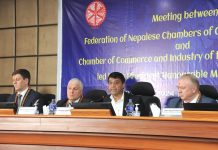With its origin, evolution and expansion throughout the world, COVID-19 has influenced almost all countries hard and harsh. It has come as a new big bang hitting almost every aspects of global human, social and economic dimensions in unexpectedly adverse manner.
It is a worldwide health pandemic causing illness to millions and death of lakhs so far. The trend is expected to rise to unknown figures with the disease remaining for unknown time period. Although it is a health issue challenging human survival, its adverse effect on global economic system is of significant magnitude.
It has compelled people to stay at home with no social and employment access. Global demand for services, consumables, materials, oil and labor force has dropped down drastically. There is supply shortage due to high disturbance in the production, operation and distribution mechanism of industries around the world. The connectivity between producers and consumers have lost completely.
The impact is severe for with no discrimination among developed, developing or least developed economies. Only the tendency and volume of severity is different.
All in all, COVID-19 has exposed entire global economy to the vulnerabilities and crisis never thought or imagined prior before this situation.
Nepal at Present
In such terrible economic scenario of the world, Nepal has not remained alone and better. The slow but expected adverse impact of COVID crisis has started to be seen in Nepalese economy. International trade is limited to essential goods only. Industries producing exportable goods, which are in few numbers, are shut down completely.
Hotel and restaurant, travel and tourism, wholesale and retail sector, daily wage based workers, tax and revenue collection mechanism, livestock farming and infrastructure projects (national and local level) have been hit hardest. The economic growth rate targeted at 8.5 % (as per Budget of Government of Nepal for FY 2076/77) is predicted to shrink down to below 3 % by different national and international economic institutions. Visit Nepal 2020 which was overly ambitious project for Nepal has already collapsed.
Remittance has declined slowly during FY 2076/77 stood at Rs.626.90 billion (as per “Macroeconomic and Financial Situation of Nepal”, Nepal Rastra Bank) at the end of nine months of the fiscal year. This trend is expected to continue with fast and large volume.
The domestic supply and distribution channel has been highly disturbed by the lockdown imposed by the Government of Nepal. The lockdown has restricted the mobilization of human and non-human resources throughout the country. The lockdown has not been effective enough in conducting mass testing, contact tracing and treatment of potential and infected COVID-19 patients. This has not facilitated the gradual re-opening and revival of the Nepalese economy.
New Economic Challenges
The challenge of this global invisible enemy is visible in almost every sector everywhere in the world. The same situation prevails in context of Nepalese economy too. COVID-19 has posted huge challenges for both internal as well as external economy of Nepal.
First of all, there is challenge of keeping our workforce healthy and safe to begin and lengthen the new economic path of the country. Doing this for those inside Nepal and expected to return soon from outside of Nepal is tough. Providing needed health facilities for such huge number with existing relatively weak healthcare structure is even more tougher task.
Practice of social distancing by all workers at all working condition is not possible. This is due to infrastructural, psychological and cultural reasons of existing working environment in Nepalese institutions.
But, there is no option than to include social distancing as new dimension of work culture in every organizations of Nepal. This tactic is even more viable in public transport, hotels, restaurants, hospitals, airlines and mass work groups of manufacturing as well as service sectors. Actually these are the sectors where people will take time to adopt this new social culture.
Secondly, disinfected packaging, distribution and delivery of goods in a country where no disinfection concept and mechanism exist is another challenge. Nepalese manufacturers do not have technical and monetary resource sufficiency to divert for such infrastructure. However, this is a must do consumer health safety and has to be done sooner or later.
Thirdly, ensuring the financial and operational safety of domestic cottage, small and medium industries is another challenge. This requires high political and financial commitment from the Government of Nepal. But this is unlikely to happen in a smooth way due to limited and declining revenue resources of the government.
Fourthly, Nepal is undergoing construction of numerous developmental and industrial projects which are to be hampered badly due to shortage of human and material resources. If these resources are available, they are at high cost burden. This is going to make these projects highly expensive and lengthen their completion time.
Similarly, managing the unemployment problem is another new challenge. This is more crucial due to addition to internal workforce internally (new job seekers and existing job losers) as well as expected outside returnees with certain level of skills and capital. What is even more pinching fact is that they all have multi-dimensional skills which cannot be pooled in a single sector of the economy.
This urges for multi-sectoral revival of the economy. This is unlikely to be done at the same time for a developing economy like Neal. Likewise, sooner or later, the fully or partially surviving industries are likely to go for more machinisation for higher productivity and economies of scale. This is surely going to be tough and must go option to go for Nepalese industries. This is expected to lead for further human job cuts adding more pressure to the labour market. However, going machinised operation for every work is not possible as it requires huge restructuring, conceptionalisation and cost.
Yet, it is the key option through which industries can go competitive both internally and externally. Along with this, the revival of service and hospitality sector is perhaps the biggest of the challenges. This sector is dependent on regular cash inflow rather than past surplus. What is even harsh is that they do not have scope for accumulated consumption as the sector begins again. So, revenue once gone is gone forever.
But this requires conceptual, contextual and constructive sectoral overhauling for desired revival and needed survival.
The anti COVID-19 measures are very hard to practice in these sectors. Still its practice is the must and the forefront way to get to new normal for these sectors. But this requires conceptual, contextual and constructive sectoral overhauling for desired revival and needed survival.
The challenges in and from the external economy in context of Nepal is also a grand one. Most of the investors outside Nepal are bound to focus on investments that can uplift their respective national economy. Of course, national economy is going to be their first priority rather than investing in not so fascinating destination like Nepal. Due to this, the scope for attracting new Foreign Direct Investments (FDI) and converting old FDI commitments into monetary form is going to be very low for Nepal. Further, due to revenue collection constraints, Nepal is not likely to further relax its tax, rebate and concessional policies to attract FDIs.
Furthermore, Nepal’s biggest foreign currency income come from remittance and tourism. Those on foreign employment have already started experiencing partial pay cuts, temporary pay holding, forced unpaid leave and even permanent job loss. This has reduced their income which at the end has contributed to the decline of remittance flow (fall of 4% in Chaitra, 2076 as per Nepal Remitters Association) to Nepal. On the other hand, tourists coming and visiting Nepal has stopped completely. Even what is more considerable is that even after far lying economic revival, they are least expected to move just like before due to their personal and national economic situation.
This means prolonged reduction in foreign currency income for Nepal. With this, Nepal is bound to use existing foreign reserve for international payment transactions which is surely going to reduce the foreign exchange reserve in the long run. Moreover, the global demand for goods and services is expected to decline largely. This means there will be considerable decline in demand for exportable gods of Nepal too. This means shut down situation for exportable goods manufacturers as well as loss of fair share of total foreign currency earnings of the country.
Finally, various new developments in global economic and trade environment is expected. The new developments could be in the form of re-innovated global production and distribution mechanism, franchising practices, production process mechanization, global business partnership and even support or favors for LDCs (Least Developed Countries) to perform international trade. To adjust to all these international scenarios is going to be a high level challenge. Within all these challenging national and international circumstances, the maintenance, re-opening and revival of the economy is a tough goal to be attained.
New Economic Opportunities
Every good challenge brings fair amount of opportunities as well. This is no different regarding COVID-19 challenges in context of Nepal. There is no logic in saying all is gone and panicking severely. In context of Nepal, this invisible virus has brought the visible opportunity to be domestically sufficient and stronger economy with reduction in external dependence. The base for this lies in land of Nepal addressed through agricultural undertakings. The production of food grains, vegetables and fruits can be expanded by just utilizing existing land and farm resources. Barren land farming can even push forward the agricultural production significantly. Existing innovative ideas and skills should be transferred to all local level farmers with initiation from governments at all levels of Nepal.
The methods of family farming, community farming and commercial farming if implemented effectively can contribute to achieve the goal of self-dependency in agriculture within next 5-7 years. At least one product for each local level must be identified and its rigorous farming in that territory with full ownership and leadership of the concerned local level. By this, minimum of 753 different products if produced in such a rigorous manner can definitely revolutionize Nepalese agriculture. With this, Nepal must opt for agro-based industrialization and commercialization.
The opportunity for commercial farming on both private as well as public owned land must be grabbed to ensure not just subsistence but industrial production of agricultural goods. The opportunity to set up agro-based industries to produce diversified agricultural and animal based products is huge. By doing this domestic self-dependency with huge import substitution of agricultural goods can be achieved.
The most promising opportunity prevails in agriculture in Nepal to be self-dependent in agriculture to overcome the COVID-19 driven economic crisis.
At this crisis time, Nepal also has got a great opportunity for import substitution in multiple sectors. With the opportunity of bulk farming, commercialization and industrialization in agriculture, Nepal can substitute the import of rice, vegetable, fruit, animal meat and herbs. It also promises opportunity to substitute raw materials for industries using imported partially processed agricultural products. With the expected completion of more hydro-power projects, addition of 1700 megawatts to the existing 1300 megawatts in FY 2077/78 (as per Policy and Programmes for FY 2077/78 of GON) is likely to happen.
The electricity produced can be utilized for industrial electrification and electric transportation in the country. This aids hugely for import substitution of oil which is the pioneer reason for unfavourable balance of trade and payment of Nepal. Such electricity production can also be used as substitute for cooking gas through consumer centric policies. Similarly, this crisis also has signified the importance of cashless and digital transaction in day to day living. This is even more vital as it avoids personal contact and reduces physical movement of people within the community.
In this regard, COVID-19 crisis has urged for more use of digital platforms for major daily financial transactions. This has made the scope of cashless and digital transaction bigger and broader in Nepal. This has offered huge opportunity to make cashless and digital Nepal. This is doable with the joint efforts of different stakeholders making the digital service a primary one for all with easy accessibility and expansion. The crisis has also compelled to think beyond traditional ideas of entrepreneurship. More online and distance driven business ideas are feasible in such situation.
This crisis also has proved the vitality of online trading and full government transaction mechanism. This has made the need and scope of e-commerce and e-governance more justifiable. Hence, it has presented with the opportunity for creating smarter Nepalese economy.
This crisis might have adverse impact on both funded and non-funded bank credits. But it has opened the way of new opportunity for agriculture credit. The agriculture credit should not now remain as a priority sector of 10 % (as per NRB Unified Directive 2076) lending of total credit of banks and financial institutions. It should be a primary sector of lending as it is the most prominent sector in context of Nepal in this crisis situation. The promotion of agricultural innovation, industrialisation and commercialization will open up more opportunities for agriculture credit bagged by government assistance in both financial and non-financial regards.
Similarly, people and businesses have realized the unpredictability of uncertain risks and need of insurance to cover it. General health insurance, life insurance, insurance against pandemic disease, medical insurance, income insurance, profit insurance, livestock insurance and crop/crop storage insurance have arrived as basic need for personal and business risk management. This has surely opened opportunity to develop new products and sell existing products for insurance companies in Nepal.
Likewise, this crisis have also provided the opportunity for health sector reforms in Nepal. Its an opportunity to improve the weak health system and poor health infrastructure of the country. It is an opportunity to mobilise existing health service to tackle short term pandemic issues.
It is an opportunity to improve existing health facilities making it more accessible to rural communities with strengthened capabilities to tackle COVID-19 and future pandemics unknown.
Finally, this crisis has provided Nepalese political parties to come together despite their different political ideologies and visions for national well-being. Frankly speaking, all other opportunities can be taken advantageously only if all political leaders grab the opportunity to come together for national welfare with higher commitment, stronger willpower, transparency and disputelessness.
| New Economic Challenges | New Economic Opportunities |
| a) Ensuring the workforce healthy and safe
b) Develop mechanism for disinfected packaging and distribution c) Maintain financial and non-financial safeguard of industry d) Developmental as well as industrial projects e) Managing the problem of unemployment f) Machinisation g) Revival of service and hospitality sector h) FDI attraction i) Foreign currency j) Reduction in export k) Lacking behind to come new global economic and trade environment |
a) Agricultural innovation and revolution
b) Agro industrialization and commercialization through new ideas c) Ensure self-dependency in food grains, herbs and animal products d) Multi-sectoral import substitution
e) Cashless and digitalized economy and lifestyle f) New entrepreneurship g) More e-commerce and e-governance scope h) Agriculture credit i) Insurance j) Health sector reforms k) Political willpower and commitment to ensure national well-being |
Conclusion
Despite being a non-economic cause, COVID-19 is adversely impacting global economy as never experienced and expected before. This invisible enemy is ruining all sectors of the global economy as done by no other causes previously. Its impact is visible in all countries challenging both human survival and economic sustainability.
Traditional Nepalese economy is also facing new challenges presented by COVID-19 to minimize the economic downfall as much as possible. To mobilize existing health resources to save human life and stop spreading of the pandemic within the nation is the forefront challenge. Along with this, adverse impact on economic variables like workforce density, industrial worse, unemployment, GDP growth, remittance, FDI, tourism, service sector, export etc. are also to be addressed ensuring as minimum loss as possible.
To maintain a balance between human survival and economic revival is the toughest challenge resulted from this crisis. Similarly, adoption of anti-covid measures in social and economic periphery of developing country like Nepal is even harder. In precise, the challenge of COVID-19 crisis is confined to all aspects of economy of Nepal with greater vulnerability for unknown longevity and unpredictable uncertainty.
With diversified new economic challenges, many new economic opportunities are available for Nepal even at this crisis time. Nepal can opt for agricultural revolution through which it can be a self-dependent nation in agricultural production. The crisis has brought in the opportunities of import substitution, economic digitalization and cashlessness, expand e-governance, insurance sector and healthcare sector reforms. All these opportunities require huge efforts and fair length of time to be realized. Nepal can overcome all these new challenges and grab these new opportunities only through transparent endeavours of the Government of Nepal.
Actually, all political ideologies must come together and stand firm unanimously at one place to combat this human crisis. There is no option other than this to design health and economic framework to come out of this crisis to ensure safety of economy and humanity of Nepal. Only by this, Nepal can come out of this COVID-19 crisis with minimal loss preventing Nepalese economy from going downhill towards extreme uncertainty.
(The writer, Ravi Dhungel, works at Nepal Bank Limited)
















